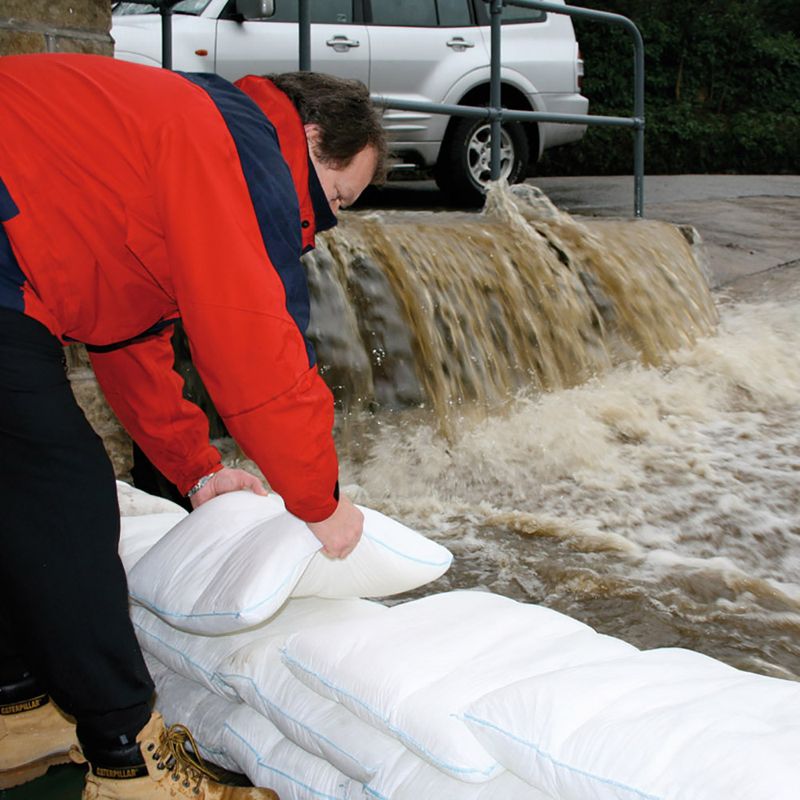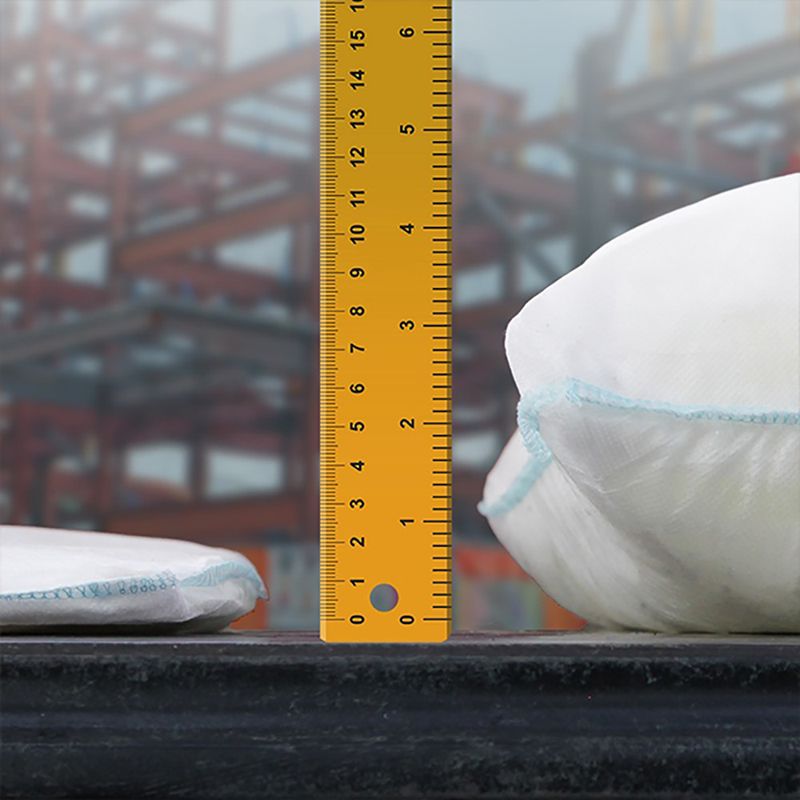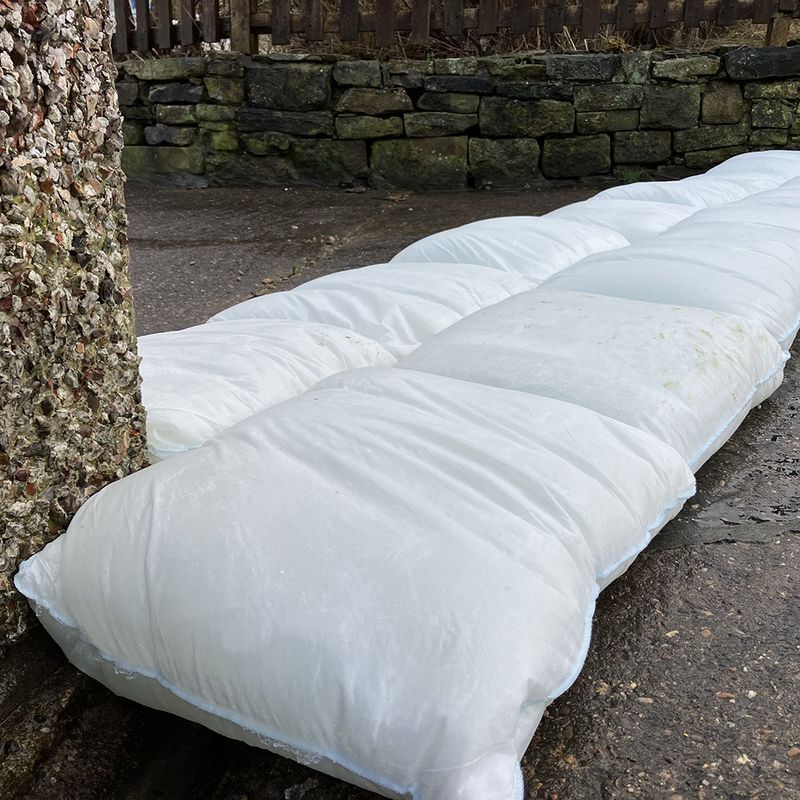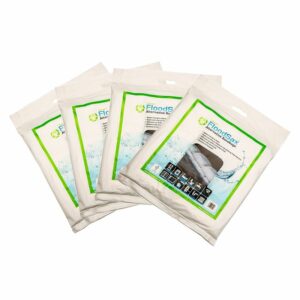Sandbags are valuable tools for flood control, offering a range of benefits in mitigating the impact of rising water levels. Their primary advantage lies in their ability to create effective barriers quickly and economically.
However, they’re far from perfect, and there are quite a few limitations to their use.
You’re probably wondering:
What can I use instead of sandbags?
The short answer – FloodSax multi-purpose sandless bags!
This high-performance modern sandbag alternative comes with a host of benefits to help protect you and your family from flooding.
Without further ado, let’s find out what they are!
Table of contents:
- Disadvantages of sandbags for flooding
- Benefits of FloodSax alternative sandbags
- How to use FloodSax as a flood barrier
- Wrapping it up
Disadvantages of sandbags for flooding
While sandbags are widely used for flood defence, they come with several disadvantages.
Here’s the deal:
Firstly, the process of filling and stacking sandbags can be labour-intensive and time-consuming, especially in emergencies where speed is of the essence. The weight and bulkiness of sandbags make transportation and placement challenging, requiring significant labour.
Secondly, sandbags may not be as effective in preventing water seepage, and over time, they can degrade or become compromised, reducing their ability to withstand the pressure of floodwaters. The disposal of used sandbags also poses environmental concerns, as they may contain contaminants picked up during use.
Thirdly, the need for large quantities of sand and labour can make the overall cost of implementing sandbag barriers relatively high, especially when considering the long-term maintenance and cleanup efforts required.
These drawbacks highlight the limitations of sandbags as a flood control measure, prompting the exploration of more modern and efficient alternatives.
No need to worry, though – FloodSax water absorbent pads to the rescue!
Having said that, let’s find out what makes this sandbag alternative stand out from the competition.
Benefits of FloodSax alternative sandbags

FloodSax alternative sandbags offer a range of benefits for flood protection and water damage prevention. When it’s dry, FloodSax is thin and highly absorbent, providing an efficient solution for soaking up drips, leaks, spills and floods in various settings. This includes hard-to-reach places like beneath pipes, radiators, sinks and boilers.
What’s more:
The innovative gelling polymer inside FloodSax absorbs water, expanding and transforming into an instant sandless sandbag in as little as five minutes, capable of retaining up to 20 litres of water. This quick activation makes them highly effective for immediate flood response.

It gets better:
The lightweight and vacuum-packed design of FloodSax ensures easy storage and transportation, making them versatile and flexible for use in tight spots. The environmentally friendly nature of FloodSax, with its biodegradability and the absence of the need for sand, contributes to the preservation of natural resources. It’s a far cry from the environmentally problematic sandbags.
Additionally, the cost-effectiveness of FloodSax, coupled with its longer-lasting durability compared to traditional sandbags, makes them a practical and economical choice for flood protection. The ease of handling, lifting, stacking and storage further enhances their usability, even for individuals with mobility challenges or the elderly.
Key takeaway:
With the potential to save significant costs and prevent the suffering associated with flooding, FloodSax stands out as a reliable and convenient solution for round-the-clock flood protection.
How to use FloodSax as a flood barrier

Now that we know the key features and benefits of FloodSax alternative sandbags, it’s time to find out how to deploy them!
Step 1: Remove the packaging
Start by opening the plastic bag containing the five FloodSax and removing them from the vacuum-wrapping and all other packaging.
Step 2: Immerse FloodSax in water
Submerge FloodSax fully in water until they have expanded completely, and the outer white cover becomes taut. This process may take up to eight minutes. As water is absorbed, continue replacing it until the FloodSax reaches maximum absorption.
You can do that using a sink, large bucket, or plastic box, with larger containers allowing for quicker inflation. Alternatively, you can utilise a wheelbarrow to activate FloodSax and transport them to the required location swiftly.
In urgent situations, such as flooding through the sewage pipes, or if time is limited, FloodSax can even be activated directly in the floodwater.
Step 3: Build FloodSax into a door barrier
For interior protection, place a dry FloodSax inside closed doors to absorb any potential seepage. You can address the specific challenge of flooding through sewage pipes by rolling a dry FloodSax and gently inserting it into the toilet; upon contact with water, it will expand and effectively seal the toilet.
Step 4: Build FloodSax into an external barrier wherever needed

Arrange the expanded FloodSax in densely packed layers to construct a barrier outside your home, ensuring overlapping rows similar to bricklaying for maximum solidity.
Keep in mind that FloodSax, like traditional sandbags, should be used for a single flooding incident due to potential contamination from filthy floodwater. However, their biodegradability allows for disposal in general waste for landfill after use.
And on that note:
Wrapping it up
FloodSax is an outstanding sandbag alternative that’s guaranteed to keep you and your family safe in case of flooding. Suitable for both indoor and outdoor use, FloodSax sandless bags are easy to deploy as a flood barrier in a matter of minutes.
And that’s not all:

A highly efficient solution, FloodSax is also a sustainable, eco-friendly solution, which is yet another feature that sets it apart from traditional sandbags.
Bottom line:
If you’re looking to reduce your carbon footprint without compromising on effective flood protection, FloodSax alternative sandbags are the obvious choice.
For more flood advice, don’t forget to check out our Flood Hub!






